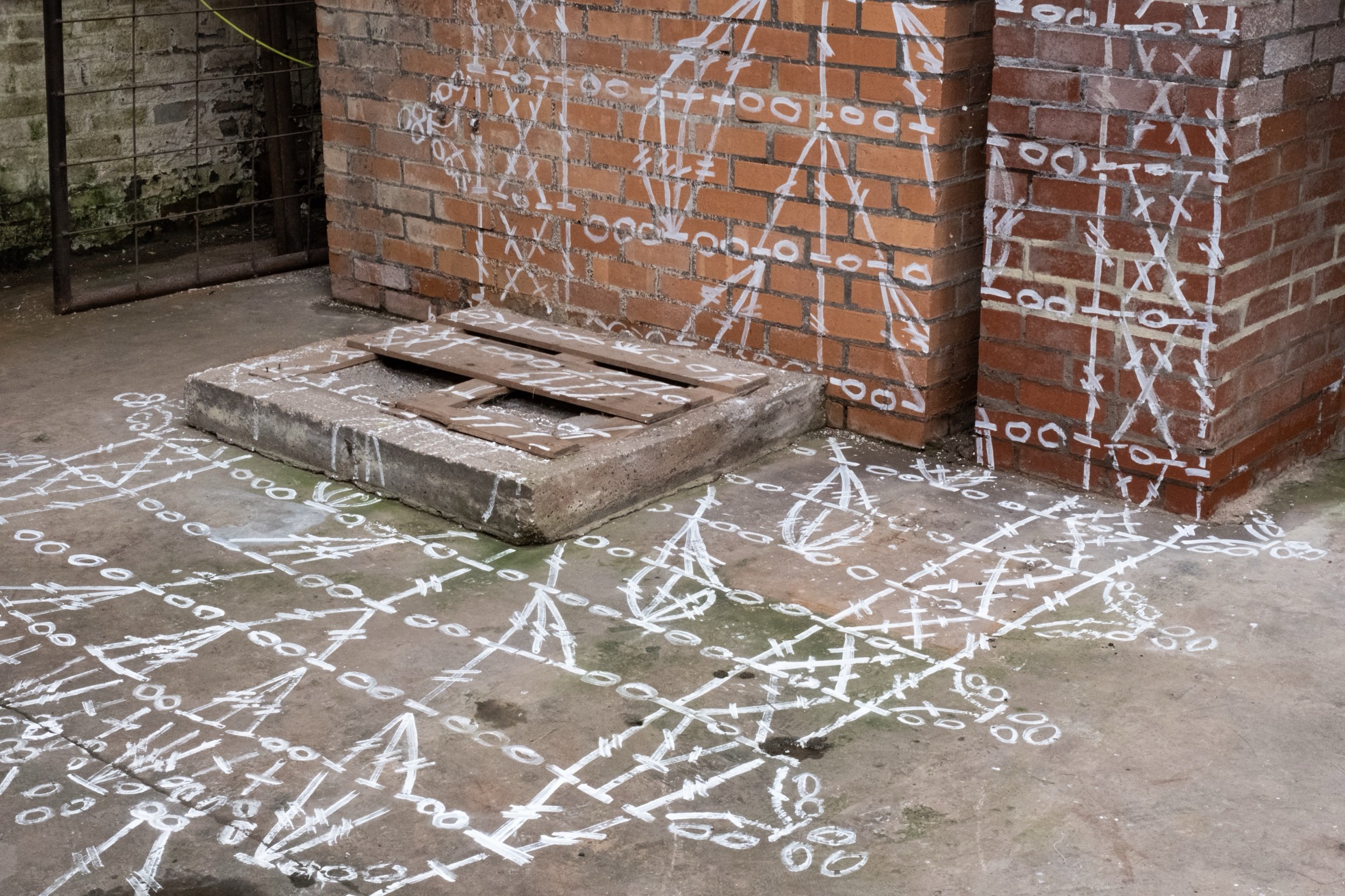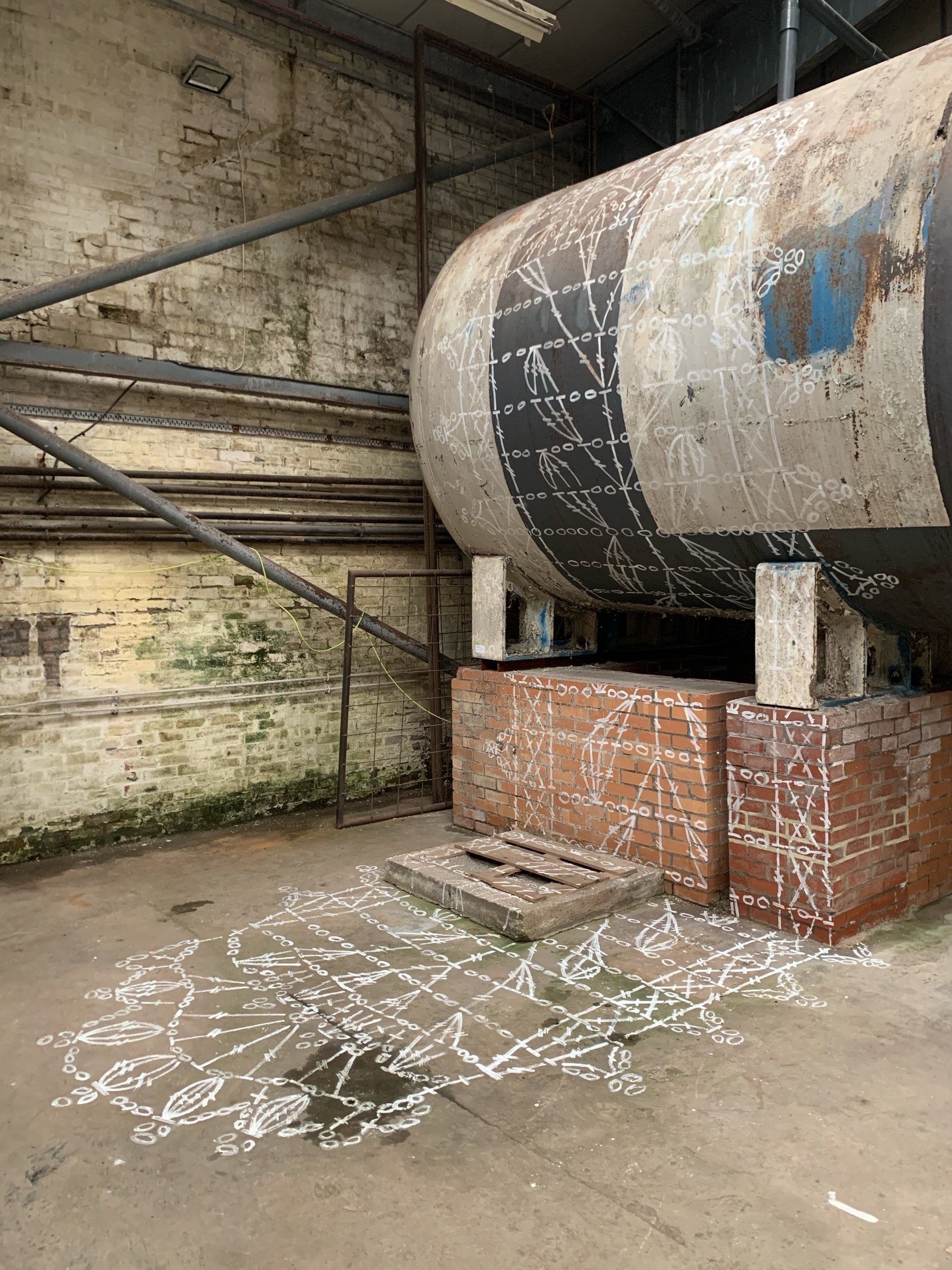Installation of Who sets the ground rules? at ICAT in Hamburg
Who sets the ground rules?
Inspired by hop scotch games and chalk doodles on the playground, this installation is comprised of a large chalk drawing of a vintage crochet pattern pulled from my family’s pattern library.
Crochet patterns, especially in rural America, were used to bind communities together through recurring symbols and motifs, oftentimes reinforcing the systems in power. Who sets the ground rules? asks us to negotiate with those everyday patterns and norms that have unseen influence on how we interact with society, even if they are as innocuous as a crochet doily. Through the chalk pattern, the ground becomes a contested location where walkers are negotiating their role in a larger socio-cultural-political space. Each step smudges, smears, and changes the ground rules.
The first rendition of this work was installed on the Lasalle College of the Arts campus in Singapore for Tropical Lab 17 in July 2023. Over the course of a month-long exhibition, students, staff, and visitors were rewriting the pattern set into Singaporean soil with every step, shuffle, and smudge.
Who sets the ground rules? Installed at the Institute for Contemporary Art Singapore on the Lasalle College of Art Campus
This work was then reimagined for a new exhibition in Hamburg in December 2023. In partnership with HFBK Hamburg, GSA MFA students were invited to Germany to share work at the Institute of Contemporary Art & Transfer. This exhibition was the sister show to the work shared in the Glue Factory for GSA + HFBK. Creating a new edition of Who sets the ground rules? allowed me to place this work in a new context, encouraging a new audience to negotiate their role in our larger socio-cultural-political spaces. Installing this work on a main thoroughfare of the building (the primary staircase) created multiple opportunities for visitors and students to interact with the chalk drawing. Whether it was tentative scurrying up the stairs or relaxed lounging on the design, this piece became the site of many conversations and gatherings. The exchange of knowledge continued with studio visits and short critiques between GSA and HFBK students. The exchange of work and knowledge through this partnership enhanced the context in which this doily pattern was received.
Who sets the ground rules? Installed at Institute of Contemporary Art Transfer in Hamburg, Germany
In a rare show of sharing creative responsibility, I sent a crochet pattern with drawing instructions to students at the University of Denver to install Who sets the ground rules? for the show F*Bomb in April 2024. I was asked to participate in this show alongside my old mentor, Sarah Gjertson. F*Bomb features the artwork of Gjertson alongside a sampling of her influences, mentors, and students. The curatorial approach for this exhibition parallels a community-centered ethos that grounds Gjertson’s artistic practice and approach as an educator. Her practice is inspired by feminist, anti-authoritarian, punk, and DIY subcultures and inspires me to think critically about the communities I make work within. This piece was installed by two current DU students, using instructions and a pattern I sent electronically. This experience forced me to give the control of making to another artist, tying into the call for action that my dissertation concluded on.
Who sets the ground rules? Installed at the Vicki Myrhen Gallery in Denver, Colorado
Most recently, as a part of the MFA degree show, I installed Who sets the ground rules? in the Glue Factory covering a large tank. The pattern drapes off of the tank and spills onto the warehouse floor, becoming a part of the Glue Factory and by extension, Glasgow’s canal and industrial history.
Detail: Who sets the ground rules? Installed for Glasgow School of Art MFA Degree Show at Glue Factory in Glasgow, UK
Who sets the ground rules? Installed for the Glasgow School of Art MFA Degree Show at Glue Factory in Glasgow, UK





